Answered step by step
Verified Expert Solution
Question
1 Approved Answer
Use the attached template below to make the STP of Puma SE Footwear in your own understanding? Consumers in the Footwear industry vary in their
Use the attached template below to make the STP of Puma SE Footwear in your own understanding?

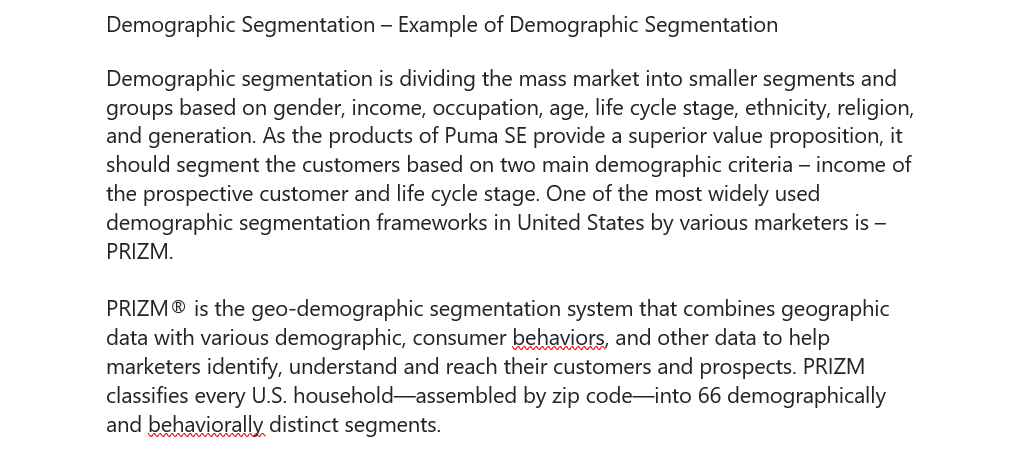
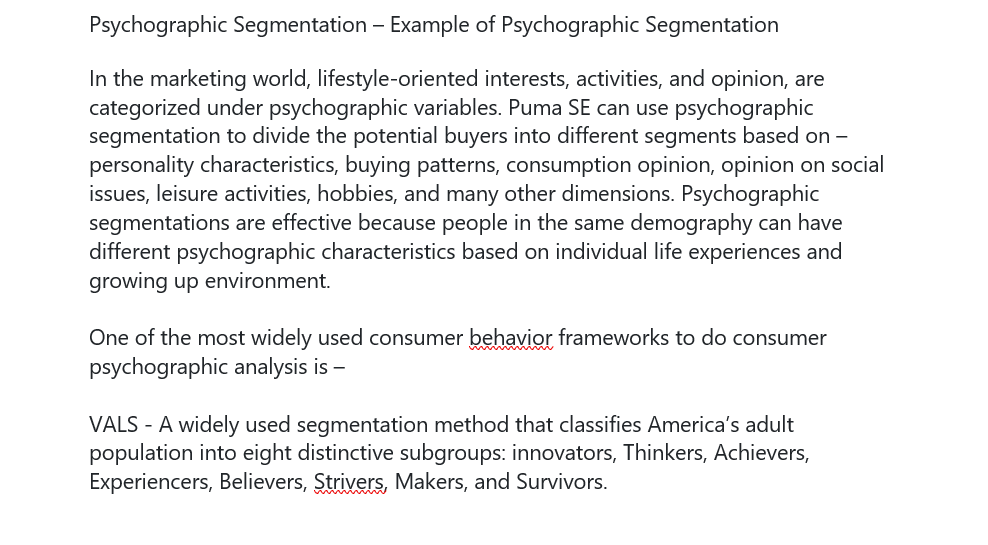
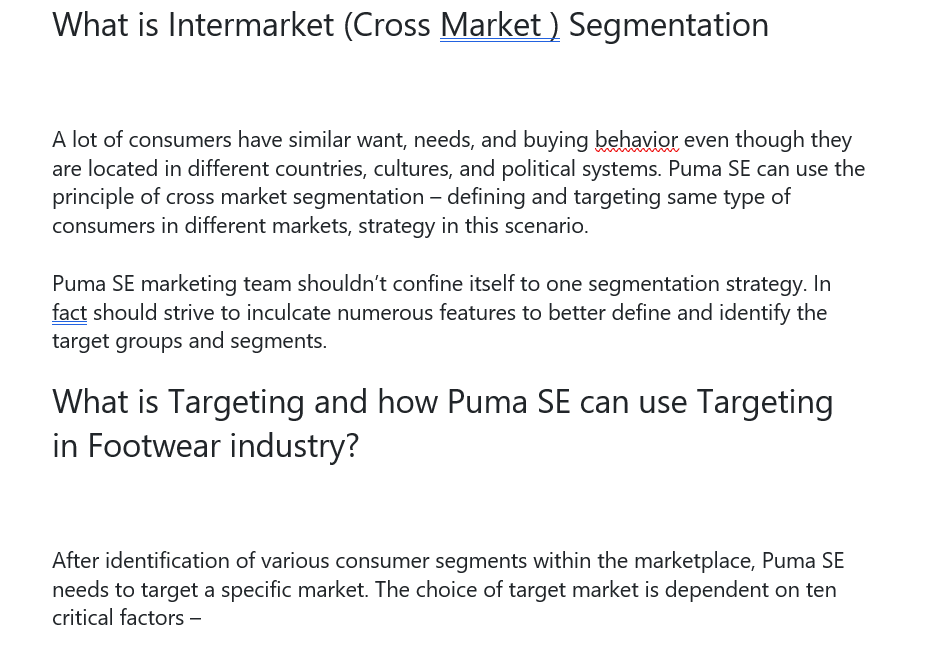
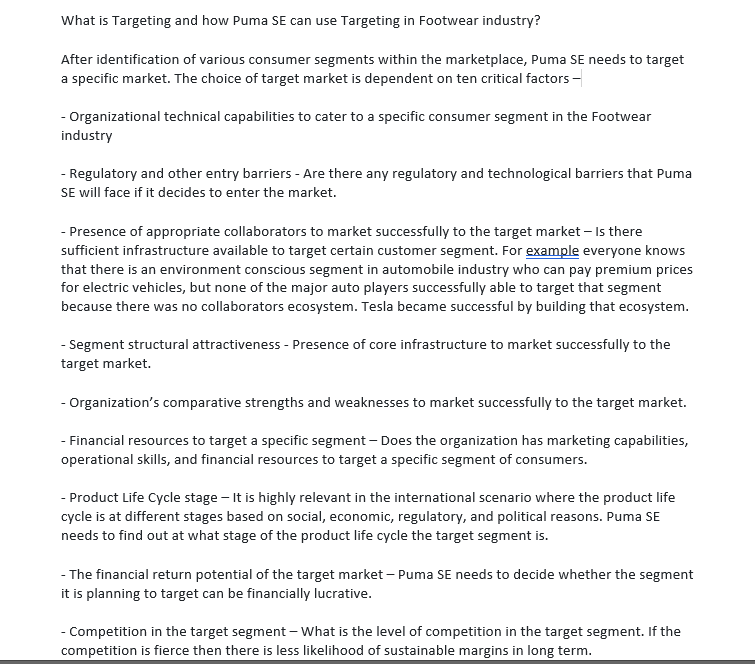
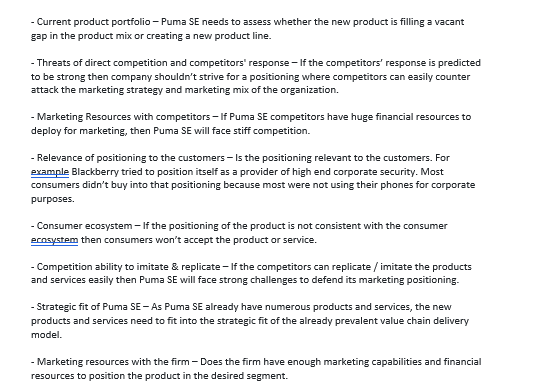
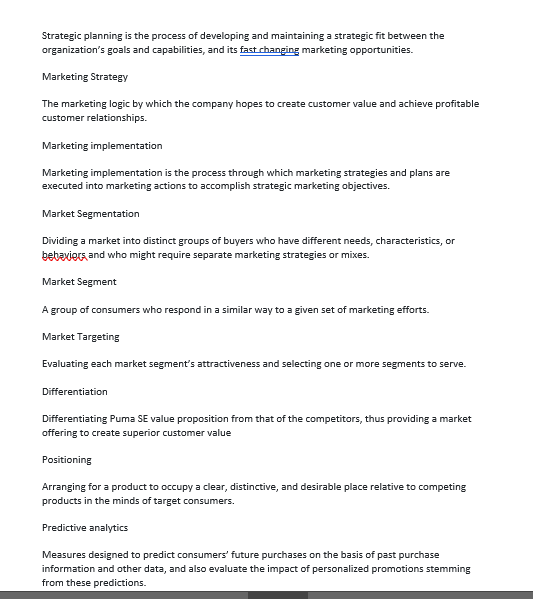
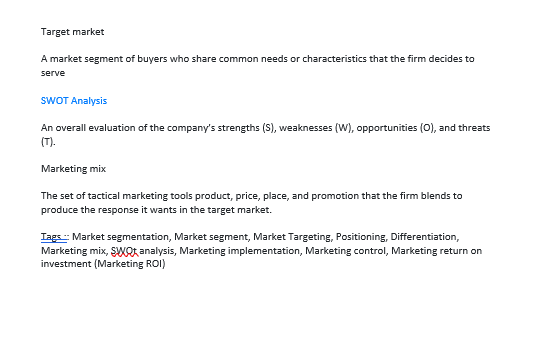 Consumers in the Footwear industry vary in their needs, wants, demands, resources, locations, access to technology, cultural differences, buying attitudes, and end use of the products and services. Market segmentation is the process through which Puma SE decides to segment the overall market in smaller segments and groups that have similar attributes, buying behaviour, socio economic background, etc. This is done to reach out to the group of consumers more efficiently and effectively. Example of Different Types of Segmentation Some of the most popular ways of consumer and market segmentation are Geographic Segmentation Geographic segmentation is dividing the overall market based on different geographic units such as - countries, continents, zip codes, states, trading blocks, cities, and neighborhoods. Geographic segmentation is highly efficient for Puma SE in the international markets because the prospective customers have different culture, preferences, and administrative systems. Secondly, if the cost of transportation is critical cost in the value proposition delivery then it is prudent to do geographic segmentation as the costs of serving customers in different locations will be completely different. Demographic Segmentation - Example of Demographic Segmentation Demographic segmentation is dividing the mass market into smaller segments and groups based on gender, income, occupation, age, life cycle stage, ethnicity, religion, and generation. As the products of Puma SE provide a superior value proposition, it should segment the customers based on two main demographic criteria - income of the prospective customer and life cycle stage. One of the most widely used demographic segmentation frameworks in United States by various marketers is PRIZM. PRIZM is the geo-demographic segmentation system that combines geographic data with various demographic, consumer behaviors, and other data to help marketers identify, understand and reach their customers and prospects. PRIZM classifies every U.S. household_assembled by zip code_into 66 demographically and behaviorally distinct segments. - Current product portfolio - Puma SE needs to assess whether the new product is filling a vacant gap in the product mix or creating a new product line. - Threats of direct competition and competitors' response - If the competitors' response is predicted to be strong then company shouldn't strive for a positioning where competitors can easily counter attack the marketing strategy and marketing mix of the organization. - Marketing Resources with competitors - If Puma SE competitors have huge financial resources to deploy for marketing, then Puma SE will face stiff competition. - Relevance of positioning to the customers - Is the positioning relevant to the customers. For example Blackberry tried to position itself as a provider of high end corporate security. Most consumers didn't buy into that positioning because most were not using their phones for corporate purposes. - Consumer ecosystem - If the positioning of the product is not consistent with the consumer erosystem then consumers won't accept the product or service. - Competition ability to imitate \& replicate - If the competitors can replicate / imitate the products and services easily then Puma SE will face strong challenges to defend its marketing positioning. - Strategic fit of Puma SE - As Puma SE already have numerous products and services, the new products and services need to fit into the strategic fit of the already prevalent value chain delivery model. - Marketing resources with the firm - Does the firm have enough marketing capabilities and financial resources to position the product in the desired segment. Strategic planning is the process of developing and maintaining a strategic fit between the organization's goals and capabilities, and its fast changing marketing opportunities. Marketing Strategy The marketing logic by which the company hopes to create customer value and achieve profitable customer relationships. Marketing implementation Marketing implementation is the process through which marketing strategies and plans are executed into marketing actions to accomplish strategic marketing objectives. Market Segmentation Dividing a market into distinct groups of buyers who have different needs, characteristics, or bebaviecs and who might require separate marketing strategies or mixes. Market Segment A group of consumers who respond in a similar way to a given set of marketing efforts. Market Targeting Evaluating each market segment's attractiveness and selecting one or more segments to serve. Differentiation Differentiating Puma SE value proposition from that of the competitors, thus providing a market offering to create superior customer value Positioning Arranging for a product to occupy a clear, distinctive, and desirable place relative to competing products in the minds of target consumers. Predictive analytics Measures designed to predict consumers' future purchases on the basis of past purchase information and other data, and also evaluate the impact of personalized promotions stemming from these predictions. Target market A market segment of buyers who share common needs or characteristics that the firm decides to serve SWOT Analysis An overall evaluation of the company's strengths (S), weaknesses (W), opportunities (O), and threats (T). Marketing mix The set of tactical marketing tools product, price, place, and promotion that the firm blends to produce the response it wants in the target market. Iags - Market segmentation, Market segment, Market Targeting, Positioning, Differentiation, Marketing mix, SWQt analysis, Marketing implementation, Marketing control, Marketing return on investment (Marketing ROl) After identification of various consumer segments within the marketplace, Puma SE needs to target a specific market. The choice of target market is dependent on ten critical factors - - Organizational technical capabilities to cater to a specific consumer segment in the Footwear industry - Regulatory and other entry barriers - Are there any regulatory and technological barriers that Puma SE will face if it decides to enter the market. - Presence of appropriate collaborators to market successfully to the target market - Is there sufficient infrastructure available to target certain customer segment. For example everyone knows that there is an environment conscious segment in automobile industry who can pay premium prices for electric vehicles, but none of the major auto players successfully able to target that segment because there was no collaborators ecosystem. Tesla became successful by building that ecosystem. - Segment structural attractiveness - Presence of core infrastructure to market successfully to the target market. - Organization's comparative strengths and weaknesses to market successfully to the target market. - Financial resources to target a specific segment - Does the organization has marketing capabilities, operational skills, and financial resources to target a specific segment of consumers. - Product Life Cycle stage - It is highly relevant in the international scenario where the product life cycle is at different stages based on social, economic, regulatory, and political reasons. Puma SE needs to find out at what stage of the product life cycle the target segment is. - The financial return potential of the target market - Puma SE needs to decide whether the segment it is planning to target can be financially lucrative. - Competition in the target segment - What is the level of competition in the target segment. If the competition is fierce then there is less likelihood of sustainable margins in long term. What is Intermarket (Cross Market) Segmentation A lot of consumers have similar want, needs, and buying behavior even though they are located in different countries, cultures, and political systems. Puma SE can use the principle of cross market segmentation - defining and targeting same type of consumers in different markets, strategy in this scenario. Puma SE marketing team shouldn't confine itself to one segmentation strategy. In fact should strive to inculcate numerous features to better define and identify the target groups and segments. What is Targeting and how Puma SE can use Targeting in Footwear industry? After identification of various consumer segments within the marketplace, Puma SE needs to target a specific market. The choice of target market is dependent on ten critical factors - Psychographic Segmentation - Example of Psychographic Segmentation In the marketing world, lifestyle-oriented interests, activities, and opinion, are categorized under psychographic variables. Puma SE can use psychographic segmentation to divide the potential buyers into different segments based on personality characteristics, buying patterns, consumption opinion, opinion on social issues, leisure activities, hobbies, and many other dimensions. Psychographic segmentations are effective because people in the same demography can have different psychographic characteristics based on individual life experiences and growing up environment. One of the most widely used consumer behavior frameworks to do consumer psychographic analysis is - VALS - A widely used segmentation method that classifies America's adult population into eight distinctive subgroups: innovators, Thinkers, Achievers, Experiencers, Believers, Strivers, Makers, and Survivors
Consumers in the Footwear industry vary in their needs, wants, demands, resources, locations, access to technology, cultural differences, buying attitudes, and end use of the products and services. Market segmentation is the process through which Puma SE decides to segment the overall market in smaller segments and groups that have similar attributes, buying behaviour, socio economic background, etc. This is done to reach out to the group of consumers more efficiently and effectively. Example of Different Types of Segmentation Some of the most popular ways of consumer and market segmentation are Geographic Segmentation Geographic segmentation is dividing the overall market based on different geographic units such as - countries, continents, zip codes, states, trading blocks, cities, and neighborhoods. Geographic segmentation is highly efficient for Puma SE in the international markets because the prospective customers have different culture, preferences, and administrative systems. Secondly, if the cost of transportation is critical cost in the value proposition delivery then it is prudent to do geographic segmentation as the costs of serving customers in different locations will be completely different. Demographic Segmentation - Example of Demographic Segmentation Demographic segmentation is dividing the mass market into smaller segments and groups based on gender, income, occupation, age, life cycle stage, ethnicity, religion, and generation. As the products of Puma SE provide a superior value proposition, it should segment the customers based on two main demographic criteria - income of the prospective customer and life cycle stage. One of the most widely used demographic segmentation frameworks in United States by various marketers is PRIZM. PRIZM is the geo-demographic segmentation system that combines geographic data with various demographic, consumer behaviors, and other data to help marketers identify, understand and reach their customers and prospects. PRIZM classifies every U.S. household_assembled by zip code_into 66 demographically and behaviorally distinct segments. - Current product portfolio - Puma SE needs to assess whether the new product is filling a vacant gap in the product mix or creating a new product line. - Threats of direct competition and competitors' response - If the competitors' response is predicted to be strong then company shouldn't strive for a positioning where competitors can easily counter attack the marketing strategy and marketing mix of the organization. - Marketing Resources with competitors - If Puma SE competitors have huge financial resources to deploy for marketing, then Puma SE will face stiff competition. - Relevance of positioning to the customers - Is the positioning relevant to the customers. For example Blackberry tried to position itself as a provider of high end corporate security. Most consumers didn't buy into that positioning because most were not using their phones for corporate purposes. - Consumer ecosystem - If the positioning of the product is not consistent with the consumer erosystem then consumers won't accept the product or service. - Competition ability to imitate \& replicate - If the competitors can replicate / imitate the products and services easily then Puma SE will face strong challenges to defend its marketing positioning. - Strategic fit of Puma SE - As Puma SE already have numerous products and services, the new products and services need to fit into the strategic fit of the already prevalent value chain delivery model. - Marketing resources with the firm - Does the firm have enough marketing capabilities and financial resources to position the product in the desired segment. Strategic planning is the process of developing and maintaining a strategic fit between the organization's goals and capabilities, and its fast changing marketing opportunities. Marketing Strategy The marketing logic by which the company hopes to create customer value and achieve profitable customer relationships. Marketing implementation Marketing implementation is the process through which marketing strategies and plans are executed into marketing actions to accomplish strategic marketing objectives. Market Segmentation Dividing a market into distinct groups of buyers who have different needs, characteristics, or bebaviecs and who might require separate marketing strategies or mixes. Market Segment A group of consumers who respond in a similar way to a given set of marketing efforts. Market Targeting Evaluating each market segment's attractiveness and selecting one or more segments to serve. Differentiation Differentiating Puma SE value proposition from that of the competitors, thus providing a market offering to create superior customer value Positioning Arranging for a product to occupy a clear, distinctive, and desirable place relative to competing products in the minds of target consumers. Predictive analytics Measures designed to predict consumers' future purchases on the basis of past purchase information and other data, and also evaluate the impact of personalized promotions stemming from these predictions. Target market A market segment of buyers who share common needs or characteristics that the firm decides to serve SWOT Analysis An overall evaluation of the company's strengths (S), weaknesses (W), opportunities (O), and threats (T). Marketing mix The set of tactical marketing tools product, price, place, and promotion that the firm blends to produce the response it wants in the target market. Iags - Market segmentation, Market segment, Market Targeting, Positioning, Differentiation, Marketing mix, SWQt analysis, Marketing implementation, Marketing control, Marketing return on investment (Marketing ROl) After identification of various consumer segments within the marketplace, Puma SE needs to target a specific market. The choice of target market is dependent on ten critical factors - - Organizational technical capabilities to cater to a specific consumer segment in the Footwear industry - Regulatory and other entry barriers - Are there any regulatory and technological barriers that Puma SE will face if it decides to enter the market. - Presence of appropriate collaborators to market successfully to the target market - Is there sufficient infrastructure available to target certain customer segment. For example everyone knows that there is an environment conscious segment in automobile industry who can pay premium prices for electric vehicles, but none of the major auto players successfully able to target that segment because there was no collaborators ecosystem. Tesla became successful by building that ecosystem. - Segment structural attractiveness - Presence of core infrastructure to market successfully to the target market. - Organization's comparative strengths and weaknesses to market successfully to the target market. - Financial resources to target a specific segment - Does the organization has marketing capabilities, operational skills, and financial resources to target a specific segment of consumers. - Product Life Cycle stage - It is highly relevant in the international scenario where the product life cycle is at different stages based on social, economic, regulatory, and political reasons. Puma SE needs to find out at what stage of the product life cycle the target segment is. - The financial return potential of the target market - Puma SE needs to decide whether the segment it is planning to target can be financially lucrative. - Competition in the target segment - What is the level of competition in the target segment. If the competition is fierce then there is less likelihood of sustainable margins in long term. What is Intermarket (Cross Market) Segmentation A lot of consumers have similar want, needs, and buying behavior even though they are located in different countries, cultures, and political systems. Puma SE can use the principle of cross market segmentation - defining and targeting same type of consumers in different markets, strategy in this scenario. Puma SE marketing team shouldn't confine itself to one segmentation strategy. In fact should strive to inculcate numerous features to better define and identify the target groups and segments. What is Targeting and how Puma SE can use Targeting in Footwear industry? After identification of various consumer segments within the marketplace, Puma SE needs to target a specific market. The choice of target market is dependent on ten critical factors - Psychographic Segmentation - Example of Psychographic Segmentation In the marketing world, lifestyle-oriented interests, activities, and opinion, are categorized under psychographic variables. Puma SE can use psychographic segmentation to divide the potential buyers into different segments based on personality characteristics, buying patterns, consumption opinion, opinion on social issues, leisure activities, hobbies, and many other dimensions. Psychographic segmentations are effective because people in the same demography can have different psychographic characteristics based on individual life experiences and growing up environment. One of the most widely used consumer behavior frameworks to do consumer psychographic analysis is - VALS - A widely used segmentation method that classifies America's adult population into eight distinctive subgroups: innovators, Thinkers, Achievers, Experiencers, Believers, Strivers, Makers, and Survivors Step by Step Solution
There are 3 Steps involved in it
Step: 1

Get Instant Access to Expert-Tailored Solutions
See step-by-step solutions with expert insights and AI powered tools for academic success
Step: 2

Step: 3

Ace Your Homework with AI
Get the answers you need in no time with our AI-driven, step-by-step assistance
Get Started


